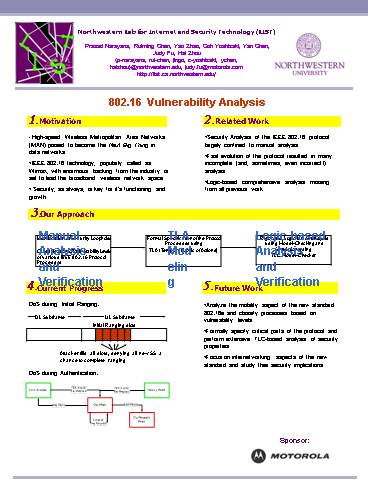Sponsor: PowerPoint PPT Presentation
Title: Sponsor:
1
Northwestern Lab for Internet and Security
Technology (LIST) Prasad Narayana, Ruiming
Chen, Yao Zhao, Coh Yoshizaki, Yan Chen, Judy Fu,
Hai Zhoup-narayana, rui-chen, jingo,
c-yoshizaki, ychen, haizhou_at_northwestern.edu,
judy.fu_at_motorola.comhttp//list.cs.northwestern.e
du/
802.16 Vulnerability Analysis
1.
2.
Motivation
Related Work
- High-speed Wireless Metropolitan Area Networks
(MAN) poised to become the Next Big Thing in data
networks - IEEE 802.16 technology, popularly called as
Wimax, with enormous backing from the industry is
set to lead the broadband wireless network space - Security, as always, is key for its functioning
and growth
- Security Analysis of the IEEE 802.16 protocol
largely confined to manual analysis - Fast evolution of the protocol resulted in many
incomplete (and, sometimes, even incorrect!)
analysis - Logic-based comprehensive analysis missing from
all previous work
3.
Our Approach
Manual Analysis and Verification
TLA Modeling
Logic-based Analysis and Verification
Identification of Security Loopholes Classification of Vulnerability Levels of various IEEE 802.16 Protocol Processes
Formal Specification of the Protocol Processes using TLA (Temporal Logic of Actions)
Rigorous, Logic-based Analysis using Model-Checking and Simulation using TLC Model-Checker
4.
5.
Current Progress
Future Work
DoS during Initial Ranging
- Analyze the mobility aspect of the new standard
802.16e and classify processes based on
vulnerability levels - Formally specify critical parts of the protocol
and perform extensive TLC-based analysis of
security properties - Focus on internetworking aspects of the new
standard and study their security implications
DL Subframe
UL Subframe
Initial Ranging slots
Attacker fills all slots, denying all new SS a
chance to complete ranging
DoS during Authentication
- Sponsor
PowerShow.com is a leading presentation sharing website. It has millions of presentations already uploaded and available with 1,000s more being uploaded by its users every day. Whatever your area of interest, here you’ll be able to find and view presentations you’ll love and possibly download. And, best of all, it is completely free and easy to use.
You might even have a presentation you’d like to share with others. If so, just upload it to PowerShow.com. We’ll convert it to an HTML5 slideshow that includes all the media types you’ve already added: audio, video, music, pictures, animations and transition effects. Then you can share it with your target audience as well as PowerShow.com’s millions of monthly visitors. And, again, it’s all free.
About the Developers
PowerShow.com is brought to you by CrystalGraphics, the award-winning developer and market-leading publisher of rich-media enhancement products for presentations. Our product offerings include millions of PowerPoint templates, diagrams, animated 3D characters and more.

